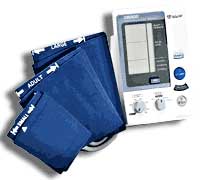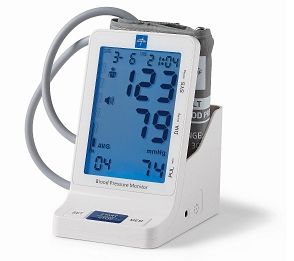Home » Hospital & Durable Medical Equipment » Digital Blood Pressure Monitors » Digital Blood Pressure Monitors
Digital Blood Pressure Monitors

Medical Quick Response Blood Pressure Monitor with Easy-Fit Cuff
Retail Price: $120.35
Your Price: $91.71
 Unit: single
Unit: single

IntelliSense Digital Blood Pressure Monitor
Retail Price: $2,169.95
Your Price: $1,520.23
 Unit: single
Unit: single

Digital Adult Blood Pressure Monitor
Retail Price: $112.54
Your Price: $87.20
 Unit: single
Unit: single
Digital blood pressure monitors are the most popular blood pressure measuring devices on the market today. Digital blood pressure monitors are easier to read than aneroid devices simply because the numbers are shown on a screen, eliminating any guessing. There are also digital blood pressure monitors that produce hardcopy printouts for efficient tracking and record keeping.
For people who regularly monitor their own blood pressure, digital blood pressure monitors are by far the best instruments to use. Opposed to manual devices, digital blood pressure monitors have a gauge and stethoscope that is one unit, which is especially good for people who are hearing impaired as there’s no need to listen to the heart through a stethoscope. Digital blood pressure monitors also have error indicators, ensuring against incorrect results. Cuff inflation is either automatic or manual while deflation is automatic. These features are highly valuable as more and more people are checking their blood pressure on a routine basis, and for good reason.
The American Heart Association reports that approximately 65 million Americans aged 20 and older have high blood pressure. High blood pressure can lead to heart diseases, strokes, heart attacks, and kidney failures. However, because there are no symptoms, approximately a third of the aforementioned figure are unaware they have it. The only way to find out if you have high blood pressure is to check it, and the easiest way to do so is to use a digital blood pressure monitor.
Routinely monitoring your blood pressure and keeping a record of the results will show you and your physician how much your blood pressure fluctuates throughout the day. Your physician can use these results to see how well your medicine is working to control your high blood pressure as well as how your diet and lifestyle may be affecting it. Using automatic digital blood pressure monitors is a good way to take part in managing your health.
When you purchase your own digital blood pressure monitor, the FDA recommends the following for in-home monitoring:
• Read the labeling to familiarize yourself with its operation.
• Have the device calibrated/validated according to the manufacturer's instructions.
• Look for a statement that says the unit was validated against the direct method of measurement.
• Make no changes in medications based on at-home findings.
Before using your digital blood pressure monitor, be sure to abide by the following guidelines:
• Don't use caffeine, alcohol, or tobacco products 30 minutes prior to testing.
• Go to the bathroom before testing.
• Rest for 3 to 5 minutes prior.
Here are some terms you should be familiar with:
• Blood Pressure is the force of blood against the walls of the artery.
• Hypertension means high blood pressure.
• Brachial Artery is a blood vessel that goes from your shoulder to just below your elbow. You measure the pressure in this artery.
• Systolic Pressure is the highest pressure in an artery when your heart is pumping blood to your body.
• Diastolic Pressure is the lowest pressure in an artery when your heart is at rest.
• Blood Pressure measurement is made up of both the systolic and the diastolic pressure. It is normally written like this: 120/80, with the systolic number first.
Proper care and storage of your digital blood pressure monitor is vital. Keep it away from heat and be sure the tubing isn’t twisted. Periodically check the tubing for cracks and leaks.
If you have any questions after evaluating our inventory, including our line of digital wrist blood pressure monitors, call us toll-free at 1-877-706-4480.














